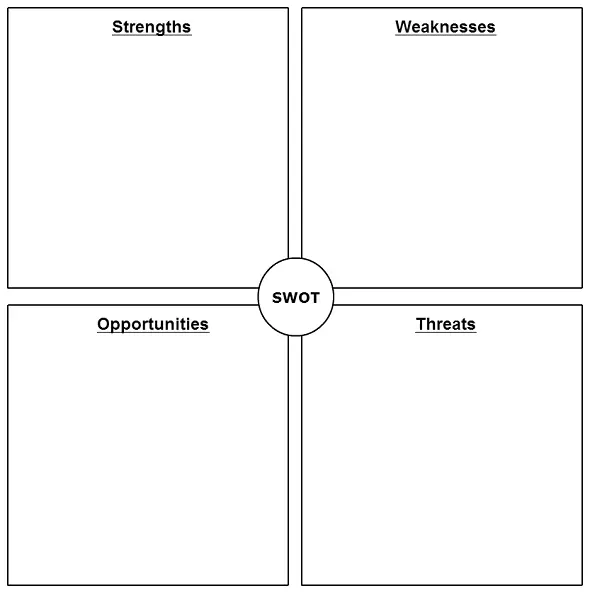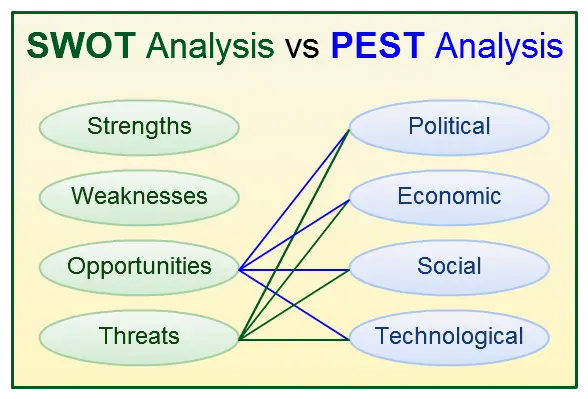SWOT analysis is used across industries to measure Strengths, Weaknesses, Opportunities and Threats of a business venture. Although it’s mainly used to assess business ventures, it can also be easily used to measure almost anything that is influenced by external and internal factors. Now that you know what a SWOT analysis is, let’s look at why you should use them and how to use them.
- What is a SWOT Analysis?
- Why Use SWOT Analysis?
- How to Use SWOT Analysis Technique Effectively
- Who Needs/Creates SWOT Diagrams
- Different Uses of SWOT Diagrams
- SWOT Analysis Best Practices
What is a SWOT Analysis?
The goal of a SWOT analysis is to identify key areas where the business can improve its performance, as well as potential risks or obstacles that may need to be addressed to achieve success. By identifying these factors, the business can develop strategies to maximize its strengths, minimize its weaknesses, take advantage of opportunities, and mitigate potential threats.
Strengths
Strengths are the internal factors that give an organization an advantage over its competitors. These may include areas such as the organization’s financial resources, intellectual property, skilled workforce, strong brand image, or proprietary technology. By identifying and leveraging these strengths, the organization can position itself to take advantage of opportunities in the market.
Weaknesses
Weaknesses are the internal factors that place an organization at a disadvantage compared to its competitors. These may include areas such as outdated technology, lack of skilled personnel, poor reputation, or limited financial resources. By identifying these weaknesses, the organization can take steps to address them and improve its overall performance.
Opportunities
Opportunities are external factors that could help an organization grow or improve its performance. These may include factors such as new markets, emerging technologies, changing consumer preferences, or regulatory changes. By identifying these opportunities, the organization can develop strategies to take advantage of them and stay ahead of the competition.
Threats
Threats are external factors that could harm an organization’s performance. These may include factors such as economic downturns, increased competition, changing regulations, or shifts in consumer preferences. By identifying these threats, the organization can develop strategies to mitigate their impact and minimize risk.
Why Use SWOT Analysis?
With hundreds of methods to assess a business venture you might wonder why use SWOT analysis over other methods. Well here are few reasons
- First introduced by Albert Humpheryin 1960’s it has stood the test of time and still effective as it was in 60’s and 70’s.
- It’s simplicity allows anyone to participate without prior knowledge of the methods and encourages participation.
- It can be used to assess places, competitors, businesses and even to do self assessments.
- Clearly differentiates between internal ( strength/weaknesses ) and external ( opportunities/threats ) factors to help decision making.
Benefits of the SWOT Analysis
SWOT analysis helps businesses and organizations understand their current position in the market allowing to develop effective strategies to improve performance and stay competitive.
SWOT analysis provides the information needed to develop effective strategic plans. It helps organizations to focus on the most important issues and develop a roadmap for achieving their goals.
It helps businesses and organizations weigh the pros and cons of different strateggic options and choose the best course of action to achieve their objectives.
The SWOT analysis helps organizations identify potential risks to its operation early on and develop strategies to mitigate them and reduce their impact.
There are many more but these are the main reasons why you should choose SWOT over other methods. Keep in mind though that some specialized methods like BPMN offer different advantages.
How to Use SWOT Analysis Technique Effectively
Now you know what and why it’s time to learn how to use them effectively.
Here are the basic steps to conducting a SWOT analysis.
Identify the objective: The first step in performing a SWOT analysis is to clearly define the objective or goal that you want to achieve. This will help you focus your analysis and ensure that you are considering the right factors.
Gather a team of expertise: Choose team members who have the relevant expertise and knowledge to contribute to the analysis. This can include managers, employees, and subject matter experts.
Gather information: Collect information about your organization’s internal and external environment. This can include data on financial performance, customer demographics, industry trends, and competitors.
Identify strengths, weaknesses, threats and opportunities: Identify the strengths and weaknesses and opportunities and threats affecting your organization and add them to the relevant quadrant of the SWOT diagram.
Analyze the results: Analyze the results of your SWOT analysis to determine the key insights and trends. This can help you identify the most important factors to consider in developing a strategic plan.
Develop a strategic plan: Develop a strategic plan that builds on your organization’s strengths, addresses its weaknesses, takes advantage of opportunities, and mitigates potential threats. This can help you achieve your goals and stay competitive in your market.
Creating a SWOT Analysis Diagram
SWOT diagram comes in various shapes but the key thing is to list down the strengths, weaknesses, opportunities and threats in an easily identifiable manner. You can get started easily by using one of our professionally designed SWOT analysis template
You can modify any of those templates online using our SWOT analysis template. If you prefer there are some templates in PDF form so you can easily download and take a printout for offline usage. Below is a blank template you can start using immediately.

Now lets look at how to enter data to the SWOT diagram.
Adding Data to the SWOT Analysis Diagram
The first thing you can do is add strengths and weaknesses. Because they are internal factors they are generally easy to identify. Depending on what you’re using the SWOT diagram these factors can vary significantly.
In a business environment they can be:
- Human resources – size of your workforce, skill level of your employees, language barriers, geographical distribution
- Financial Situation – Capital, investment capacity, income, predicted profit, seasonal income
- Distribution – sales partners, regional distribution, supply chain efficiencyproduction capabilities
- Operations – Efficiency of software, operation and implement cost of software, efficiency of reporting processes
Depending on the organization there can be many more areas that can be a strength or a weakness. For example for a company like Apple brand loyalty is a great strength while for Samsung it could be low production cost.
As mentioned above adding internal factors are somewhat easy. The hard part comes when adding external factors, opportunities and threats.
Fortunately there is a formal process called PEST analysis to assess those opportunities and threats. Check out our SWOT vs PEST article to learn about similarities and differences.
PEST stands for Political, Economic, Social and Technological factors. Sometimes it’s referred as PESTLE analysis with Legal and Environmental factors added to the mix.

PEST provides you a structured and a formal way to assess the opportunities and threats. Different departments can work on different areas and come up with the necessary data needed for the final SWOT diagram. For large projects there is simply no option but to direct these to different departments.
Below is a breakdown of different areas and some important factors in those areas.
- Political – Government stability, corruption levels, trade controls, import and export restrictions
- Economic – Exchange rates, interest rates, income levels of population, wealth distribution
- Social – Education levels, religious harmony, attitude towards health, social welfare programs
- Technological – Internet penetration, access to basic infrastructure, software piracy, technology competency of workforce
- Legal – Tax laws and regulations, labor laws and firing policies, copyright and anti-piracy laws
- Environmental – Weather patterns, attitude towards recycling, attitude towards organic and green products
Obviously all the factors don’t apply to every organization. For example if you’re selling computers then weather patterns might not interest you but they are definitely important if you’re selling rain coats.
Who Needs/Creates SWOT Diagrams
SWOT analysis are used by decision makers who are part of the planning of a venture. So most of the time they’re used by managers and senior executives. But as I mentioned before they can be applied in many scenarios so almost anyone can be creating SWOT diagrams.
If it’s a large project then they are usually created during lengthy multiple meetings. Managers of different departments, senior level executives and many others might get together and work on the SWOT analysis.
- Businesses: Business owners and managers can use a SWOT analysis to assess their company’s internal and external environment, identify areas of improvement, and develop a strategic plan to achieve their goals.
- Individuals: Individuals can use a SWOT analysis to assess their own strengths and weaknesses, identify areas for personal growth, and make career or life decisions.
- Non-profit organizations: Non-profit organizations can use a SWOT analysis to evaluate their programs, fundraising strategies, and volunteer engagement.
- Governments: Governments can use a SWOT analysis to evaluate their policies and initiatives, identify areas for improvement, and develop plans to address community needs.
A software like Creately with it’s real-time collaboration tools helps teams to collaborate on SWOT diagrams easily while always visualizing the changes made by others. The revision history is preserved so it’s clearly visible who made the changes and this makes it easy to reverse decisions as well.
Different Uses of SWOT Diagrams
SWOT can be used to cater to hundreds of scenarios. Here’s a look at some common situations where SWOT analysis becomes very useful.
I personally feel personal SWOT analysis is underutilized. It’s a great way to prepare for an interview. Especially so if it’s an internal interview for a promotion and you know who you’re up against. This enables you to focus on your strengths and how those strengths align with opportunities for the company. And it helps to stay clear or talk less about your weaknesses. Check out this FORBES article for a in depth look at doing a personal SWOT analysis.
Another area where SWOT analysis is heavily used is marketing. Marketing is all about getting ahead of your competitors and knowing their strengths and weaknesses helps to focus your message and highlight the strong points.
For example in our case we’re the only diagramming software that offers an online solution and an offline desktop solution that syncs with each other. This is obviously useful for frequent travelers who want access to their diagram from anywhere in the world. And we make sure to highlight this in conferences and meet-ups. Check out this article about using SWOT in marketing to see how you can apply them to your marketing plans.
SWOT Analysis Best Practices
- To ensure a comprehensive analysis, involve a diverse group of stakeholders with varying perspectives and experiences. This can include employees, customers, partners, suppliers, and industry experts.
- Avoid bias and be honest when evaluating strengths, weaknesses, opportunities, and threats. This will help to identify potential blind spots and areas for improvement.
- Once you have identified your strengths, weaknesses, opportunities, and threats, prioritize actions based on impact and feasibility. Develop a plan of action to address the most critical issues.
- Use a simple and straightforward format that is easy to understand and communicate. This can be a table or a simple list.
- A SWOT analysis is not a one-time exercise. Continuously review and update your analysis to ensure it remains relevant and useful.
I hope this article has helped you to understand what SWOT analysis are, why it’s used around the world and how you can use it to make better decisions. As always if you have any question feel free to ask them in the comments.
FAQs
What are the common mistakes to avoid during a SWOT analysis??
Avoid being overly optimistic or pessimistic about the strengths, weaknesses, opportunities, and threats. This can lead to a biased analysis that is not based on facts and data.
Not involving key stakeholders. To get a comprehensive analysis, it is important to involve all key stakeholders.
Avoid analyzing too many factors or getting lost in details. Instead, focus on the most important factors that will have the greatest impact on your goals.
Confusing internal and external factors. Internal factors are within your control, while external factors are outside of your control. It is important to distinguish between these factors and address them accordingly.
Avoid ignoring potential threats or weaknesses. Identifying and addressing these issues can help to prevent problems and minimize risks.
How to gather resources for a SWOT analysis?
Refer and review internal data such as financial statements, employee feedback, customer reviews, and operational data. This can help you to identify your company’s strengths and weaknesses.
Conduct market research to gather information about your industry, competitors, and customers. This can help you to identify potential opportunities and threats.
Gather feedback from stakeholders such as employees, customers, partners, and industry experts. This can provide valuable insights and different perspectives.
Seek out expert opinions from industry analysts, consultants, and other professionals.





